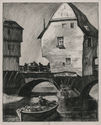
19th, 20th & 21st Century Fine Prints
707-546-7352 · fax 707-546-7924 · web: www.annexgalleries.com · email: artannex@aol.com
Amos Sewell Biography
Amos Sewell
American
1901–1983
Biography
Amos Sewell was an American illustrator, best known for the covers and illustrations he designed for several major publications including The Saturday Evening Post, and for his depictions in popular 20th century pulp magazines. He had a special empathy for children and also particularly enjoyed drawing homespun, rural subjects.
Born in Oakland, California, on June 7, 1901, Sewell started out as a ranked amateur tennis player. He found work as a banker during the day and took night classes at the California School of Fine Arts (now the San Francisco Art Institute), off and on for about eight years. Though he dedicated himself to tennis for much of his teen and young adult years, it was art that captured his attention and he quit the sport in the late 1920s. In hopes of finding a job in illustration he would send unsolicited interior scenes to various publications in the hopes of finding work as a freelance illustrator, with some early success. However, with the crash of the stock market in 1929, he lost his bank job and life was upended. On his 29th birthday he decided to try a new path, and left San Francisco on a lumber boat headed for New York by way of the Panama Canal. He earned his keep by working for the crew.
In New York City, Sewell took classes at the Art Students League and the Grand Central School of Art. He studied under such famed teachers as Guy Pene Du Bois, Harvey Dunn, and Julian Levy. During this time, Sewell was commissioned to draw black and white dry-brush illustrations for popular pulp magazines including Clues and Terror Tales.
Though the Great Depression made work difficult to find, Sewell managed to become one of the few financially stable working artists of the early to mid-20th century, receiving regular work from advertising agencies and magazines around the city. In 1936 he married Ruth Allen, and they soon relocated to Westport, Connecticut. He illustrated his first major manuscript for The Country Gentleman in 1937; next came many covers for The Saturday Evening Post, as well as numerous other assignments for Woman’s Day, Good Housekeeping, Redbook, Liberty, and Coronet, among others.
Amos Sewell's work was considered among the finest of his genre, due to the quality of his work outside of the commercial sphere. His charcoal drawings were especially fine, and were used as an example of the technique in Henry Pitz' The Practice of Illustration (New York. Watson-Guptill Publishers, Inc., 1947). The Sewell's remained in Westport, where they lived a quiet life until Amos' death in October 1983 at the age of 82.
Sources: Pulpartists.com, Illustrationhistory.com

